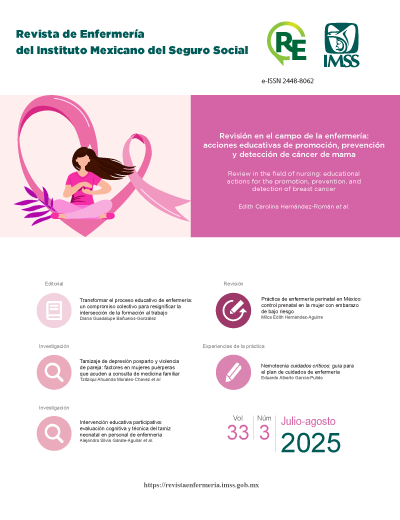Perinatal nursing practice in Mexico: prenatal care for women with low-risk pregnancies
Main Article Content
Keywords
Primary Care Nursing, Prenatal Care, Neonatal Nursing, Low-Risk Pregnancy
Abstract
Introduction: Prenatal care is essential for monitoring pregnancy and is generally performed by specialized medical personnel. It is believed that perinatal nurses could perform this care for women with low-risk pregnancies, a situation that already occurs in some clinics in the country; however, there is no information on the practices of these professionals.
Objective: To analyze published articles on perinatal nursing practice in prenatal care for women with low-risk pregnancies from 2014 to 2024.
Methodology: A PRISMA systematic review was conducted. The search for articles was made in SciELO, Redalyc, Elsevier, PubMed, and Google Scholar. Indexed articles published in English or Spanish in Mexico between 2014 and 2024, among women with low-risk pregnancies, were reviewed. The final sample consisted of 14 articles.
Results: Perinatal nursing practice consists of comprehensive prenatal care, counseling, nutritional interventions, risk and complication screening, and development of care/delivery plans.
Conclusions: Expanding the role and increasing autonomy in perinatal nursing practice can lead to greater benefits for pregnant women. Due to their training and competencies, nurses can provide comprehensive prenatal care for women with low-risk pregnancies and collaborate with other professionals, in the case of women with high-risk pregnancies.
References
Organización Mundial de la Salud. Mortalidad materna. 2023. Disponible en: https://www.who.int/es/news-room/fact-sheets/detail/maternal-mortality
Secretaría de Salud. Informe nacional de notificación inmediata de muerte materna, semana epidemiológica 52 de 2023. México: Secretaría de Salud; 2023. Disponible en https://www.gob.mx/cms/uploads/attachment/file/878706/MM_2023_SE52.pdf
Secretaría de Salud. Informe nacional de notificación inmediata de muerte materna, semana epidemiológica 52 de 2022. México: Secretaría de Salud; 2022. https://www.gob.mx/cms/uploads/attachment/file/788958/MM_2022_SE52.pdf
Dioses D, Corzo C, Zarate J, et al. Adherencia a la atención prenatal en el contexto sociocultural de países subdesarrollados: una revisión narrativa. Horiz Med [Internet]. 2023;23(4). Disponible en: http://www.scielo.org.pe/pdf/hm/v23n4/1727-558X-hm-23-04-e2252.pdf
Instituto Mexicano del Seguro Social. Guía de Práctica Clínica Control prenatal con atención centrada en el paciente. México: IMSS; 2017. Disponible en: https://www.imss.gob.mx/sites/all/statics/guiasclinicas/028GER.pdf
Procuraduría Federal del Consumidor. Gastos en la gestación de un bebé ¿La torta bajo el brazo? México: Profeco; 2023. Disponible en: http://www.gob.mx/profeco/documentos/gastos-en-la-gestacion-de-un-bebe-la-torta-bajo-el-brazo?state=published
Centro Nacional de Equidad de Género y Salud Reproductiva. Clínica Comunitaria de Santa Catarina en Iztapalapa: pionera en la incorporación de enfermeras obstetras y perinatales. Boletín Mensual de Salud Sexual y Reproductiva. 2022;1(5). Disponible en: https://www.gob.mx/cms/uploads/attachment/file/762991/Boleti_n_N5_JUL_22.pdf
Instituto Nacional de Perinatología. Se empodera enfermería con Nursing Now. México: INPer; 2020. Disponible en: https://www.gob.mx/salud%7Cinper/prensa/se-empodera-enfermeria-con-nursing-now
Jiménez Y. Empoderamiento, una herramienta en el desempeño profesional de Enfermería en la promoción y prevención de salud. Rev Cuba Enferm. 2023;29.
Gómez-Torres D, Télles-Rojas G, Parreira PMSD, et al. Percepción social de usuarias atendidas exclusivamente por enfermeras en la etapa perinatal. Enferm Actual en Costa Rica. 2018;(35). Disponible en: https://revistas.ucr.ac.cr/index.php/enfermeria/article/view/33666
Oviedo A, Rodríguez C, Ruíz A, et al. Cuidados del control prenatal en el primer nivel de atención en relación a la NOM-007-SSA2-1993. Waxapa. 2015;7(13).
Quinzaños-Fresnedo C, Ríos-Castillo B, Hernández-Gordillo HC, et al. La necesidad de un cambio de paradigma en atención materna: Modelo AMIIMSS, alcances y retos. Rev Med Inst Mex Seguro Soc. 2022;60(Supl 2):119-26. Disponible en: https://pmc.ncbi.nlm.nih.gov/articles/PMC10651308/
Tapia H, Lossi M, Pérez I, et al. Obstetric profile of pregnant adolescents in a public hospital: risk at beginning of labor, at delivery, postpartum, and in puerperium. Rev Lat Am Enfermagem. 2015;23(5):829-36.
Abarbanell L. Mexico’s Prospera Program and Indigenous Women’s Reproductive Rights. Qual Health Res. 2020;30(5):745-59.
Ortiz-Félix RE, Cárdenas-Villarreal VM, Miranda-Félix PE, Guevara-Valtier MC. Impact of a prenatal education intervention in pregnant women to prevent overweight in infants. Gac Med Mex. 2021;157(1):3-9. English. doi: 10.24875/GMM.M21000529
Bermudez Rojas MDLL, Medina Jimenez V, Manzanares Cuadros JI, et al. Universal prenatal screening: a initiative from Guanajuato, Mexico to improve equity in perinatal healthcare. Front Med. 2023;10:1127802.
Moreno E, Becerril V, Alcalde J. Conocimientos tácito y explícito: análisis comparativo de la priorización de problemas de salud materna en México. Gac Sanit. 2018;32(3):251-61.
Gómez D, Rojas GT, Garduño MDM, et al. Autonomía profesional de la enfermería perinatal: percepción social de competencias conquistadas. Rev Enferm UERJ. 2019;27.
Osorio M, Landa R, Blázquez M, et al. Conocimiento y factores de abandono sobre lactancia materna en mujeres embarazadas. Horiz Sanit. 2019;18(2). Disponible en: http://revistas.ujat.mx/index.php/horizonte/article/view/2691
Guzmán-Ortiz E, Cárdenas-Villarreal VM, Guevara-Valtier MC, et al. Estado nutricio saludable en la mujer durante la gestación: teoría de rango medio. Enferm Univ. 2018;15(3). Disponible en: http://revista-enfermeria.unam.mx:80/ojs/index.php/enfermeriauniversitaria/article/view/520
Centeno-Pérez MA, Mata-García AD, Plascencia-Ordaz MJ, et al. Modelo de autocuidado de enfermería perinatal. Perinatol Reprod Humana. 2017;31(3):151-9.
Hartmann A, Nazar-Beutelspacher D, Salvatierra-Izabá E. Desventaja social y utilización de servicios de salud para recibir atención prenatal en niñas y adolescentes de barrios pobres de Chiapas. Entreciencias. 2020;8(22). Disponible en: https://www.redalyc.org/journal/4576/457662386018/457662386018.pdf
Castillo IY, Bohórquez C, Zarate RA, et al. Utilización del control prenatal en gestantes de la delegación Iztapalapa, Distrito Federal de México. Arch Med Manizales. 2019;19(1):46-55.
Guarnizo Á, Bermúdez S, Torres Ó, et al. Diagnóstico y evaluación de la esclerosis múltiple: Lo que el radiólogo debe conocer e informar. Conceptos actuales. Rev Colomb Radiol. 2017;27(4):43-55.
Chabbert M, Panagiotou D, Wendland J. Predictive factors of women’s subjective perception of childbirth experience: a systematic review of the literature. J Reprod Infant Psychol. 2021;39(1):43-66.
Landry I, René C, Demontigny F. Family centered nursing practices towards women and their families in the birthing context: A qualitative systematic review. Nurs Open. 2023;10(9):5937-49.


